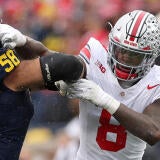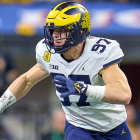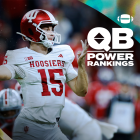NFL combine 2022 drills: Pinpointing promising 3-cone times for edge rushers over the years
Factoring in height and weight was the foundation of this study

This edge rusher class is stacked. Loaded up. Filled with talent. However you want to describe the group, it's good. Really good. From Aidan Hutchinson to Kayvon Thibodeaux to David Ojabo to Jermaine Johnson to Boye Mafe and a myriad of other top talents, it's a collection of outside pass rushers with a varying array of power, pass-rushing moves, burst, bend, and closing speed.
We could see as many as six edge rushers in Round 1, and probably 5-10 more will go before the end of Day 2. I'm serious.
The combine has a drill -- the three-cone -- that strongly correlates with NFL success at the edge-rusher position. Probably because it's a drill that explicitly measures a prospect's ability to tightly bend the corner and accelerate around it. Very translatable to what edge rushers are asked to do on many of their rushes to the quarterback on passing plays.
The 7.00-second threshold has forever been the gold-standard in three-cone times for edge defenders. If you're under that time, you're good. If you're not, red flag. And, sure, we all collectively realized there should be more leeway with that time for a heavier prospect.
Well, back at the outset of the pandemic, I spent some time adding more context to that prestigious 7.00 threshold for edge rushers because I realized we needed to go deeper than just adjusting how quick an edge rusher's three-cone time was strictly based on weight. Height had to be considered, too, because 6-foot-2 and 260 pounds is anatomically much different than 6-5, 260.
So I got to work, mapping out the heights, weights, and three-cone times for edge rushers over the past 10 years at the combine in a scatter chart and used Excel to draw a best-fit line based on the figures. That line would clearly show where the three-cone time threshold should really be based on an edge defender's height and weight.
What I found was striking. Before I show you the charts, here are some guidelines for what I'm calling the Calculated Combine Context (CCC) study:
- Since we didn't have a combine last year, the sample size is from 2010 to 2020. I couldn't rely on pro day numbers in a study focusing on exact numbers out to the hundredth of a second like this one.
- Players' heights were rounded up starting at one-half of an inch. (For example: 6'2 1/2" counted as 6-3.)
- Only edge rushers who participated in the three-cone drill at the combine were included in the study.
And here is the study's key:
- Players highlighted in black ran a slower time than the best-fit line for their height but have made a Pro Bowl.
- Players highlighted in green ran a faster time than the best-fit line for their height and have made a Pro Bowl.
- The X axis is player weight.
- The Y axis is three-cone time in seconds.
Now, I know a Pro Bowl appearance isn't today's finest way to identify a quality player. And while Pro Bowl voting has gotten watered down over the years, it's still a mostly reliable indicator of who's at least pretty good, and who isn't.
Below are the charts, starting with the 6-2 edge rushers and finishing with the 6-5 edge rushers. The vast majority of them from 2010 to 2020 were in that height range.
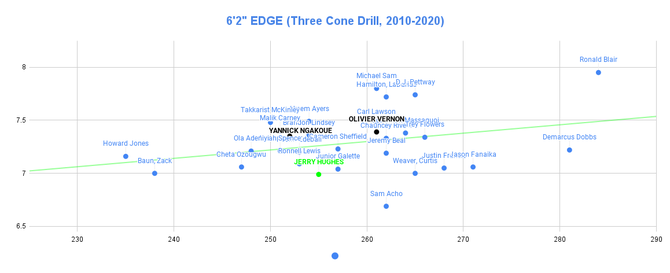
Not an enormous sample here, and the players above the line (Yannick Ngakoue, Olivier Vernon) outnumber the Pro Bowler under the line (Jerry Hughes). Far from a tremendous start for those thinking three-cone time matters for edge rushers.
Now onto the 6-3 rushers. There's way more of them.

This is the subsection of the sample size in which a real trend emerges. Six of the Pro Bowlers under the line (Von Miller, Vic Beasley, Harold Landry, Khalil Mack, Frank Clark, and Justin Houston) outnumber the two above the line (DeMarcus Lawrence, Matthew Judon).
Thanks in large part to Miller and Mack, this group features seven first-team All-Pro selections, along with a Defensive Rookie of the Year and Defensive Player of the Year nod.
Heading into the 6-4 group, we're at seven Pro Bowlers under the line (faster than than the expected three-cone time) and four above the line (slower).

Here, the trend continues. There are nine Pro Bowlers below the line (Aldon Smith, Ryan Kerrigan, Trey Hendrickson, Cameron Jordan, T.J. Watt, Whitney Mercilus, Greg Hardy, Robert Quinn and Nick Bosa) to just two above it (Bradley Chubb, Za'Darius Smith).
Oh, and for the life of me, I could not get Bosa's name to appear on this chart. He was just under 6-4 and 266 pounds at the 2019 combine and -- no surprise -- was under the line with his 7.10 time. He should appear right between Robert Quinn and Trey Hendrickson.
Through the 6-4 rushers, there are 16 defenders below their best-fit line and six above it.
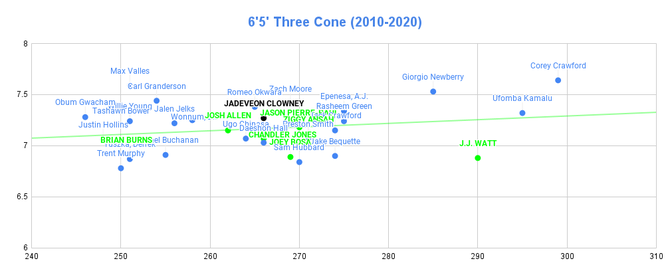
At this height, there are seven Pro Bowlers under the line (Joey Bosa, J.J. Watt, Brian Burns, Chandler Jones, Josh Allen, Jason Pierre-Paul, Ziggy Ansah) to just one above it (Jadeveon Clowney).
That moves the final count to 23 who had a three-cone time above their respective best-fit line and seven below it.
Pretty striking right?
Even if we already simply expected the faster times to correlate with the better players, with these charts, we now know what constitutes a "fast" time relative to height and weight for edge rushers.
Going into the 2022 combine, feel free to use these CCC charts to check how "good" three-cone times are for all the top edge rushers after getting their measurements.




